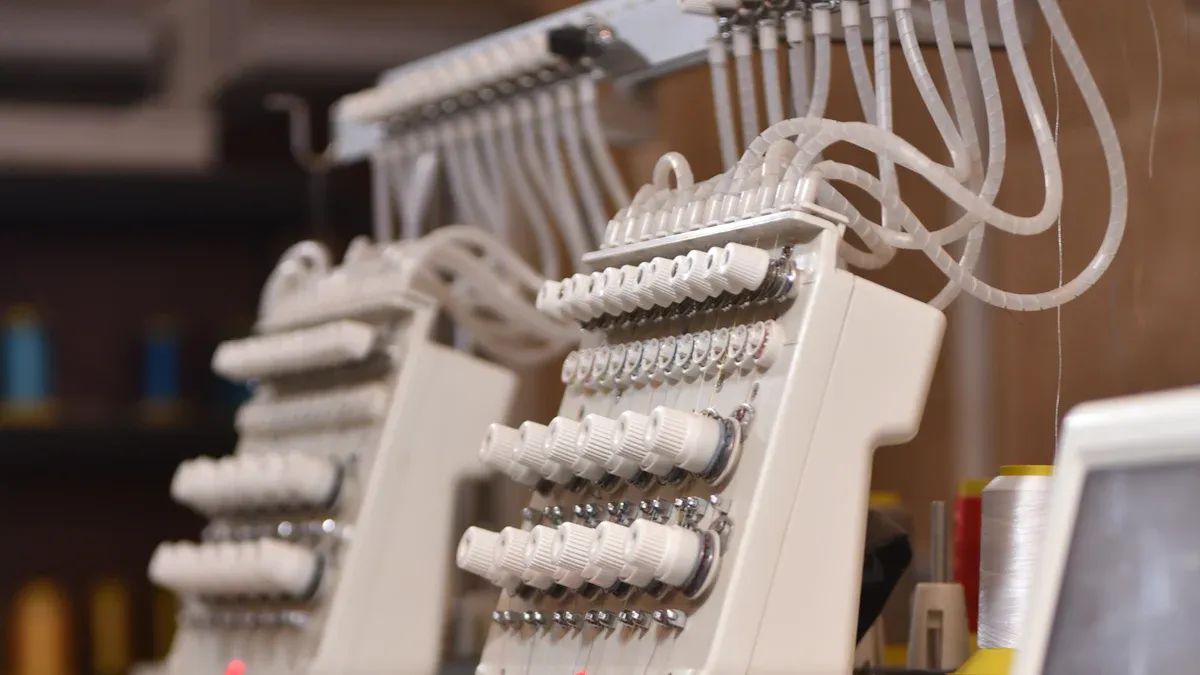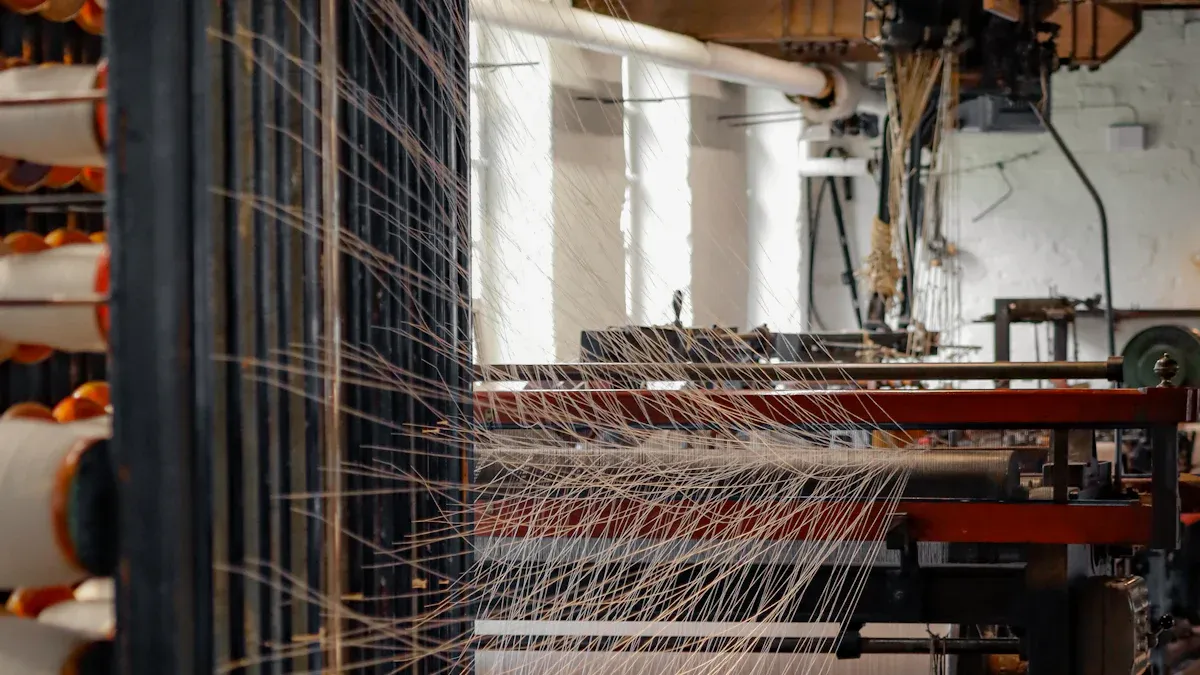Using Power Management ICs A4984SESTR-T in the future for Textile Automation

Textile automation needs accuracy and speed for modern production. The A4984SESTR-T motor driver is very important for this. It helps textile machines do complex tasks with great precision. By improving motor control, it uses less energy and saves money. Its strong design makes it dependable for nonstop production. From weaving to embroidery, this motor driver improves textile work, creating smarter and faster manufacturing systems.
Key Takeaways
The A4984SESTR-T motor driver improves accuracy in textile work, helping with tasks like embroidery and weaving.
It saves energy, which lowers costs and helps the environment.
This motor driver is built to last, perfect for nonstop textile work.
Setting it up correctly is important to keep machines running well.
The A4984SESTR-T works with IoT systems for remote control and live monitoring.
Overview of the A4984SESTR-T Motor Driver
The A4984SESTR-T motor driver helps control stepper motors with accuracy. Made by Allegro MicroSystems, it is used in machines needing precise motor control. These include textile machines, 3D printers, and CNC machines. Its strong design and advanced features make it dependable for automation.
Key Features of the A4984SESTR-T
The A4984SESTR-T has many features that make it special:
Microstepping Capability: Allows smooth motor moves with steps like 1/2 or 1/8.
Wide Voltage Range: Works with voltages from 8V to 35V for flexibility.
High Output Current: Gives up to 2A, ensuring strong motor power.
Integrated Protection: Protects against overheating and short circuits for safety.
Compact Design: Small size fits tight spaces, perfect for small setups.
These features make the A4984SESTR-T a great choice for industries needing reliable motor control.
Technical Specifications of the A4984SESTR-T
The A4984SESTR-T has specific limits and abilities. The table below shows its main details:
Specification | Value |
|---|---|
Part No | A4984SESTR-T |
Manufacturer | Allegro MicroSystems |
Voltage - Load | 8V ~ 35V |
Current - Output | 2A |
Voltage - Supply | 3V ~ 5.5V |
Step Resolution | 1, 1/2, 1/4, 1/8 |
Operating Temperature | -20°C ~ 150°C (TJ) |
Output Configuration | Half Bridge (4) |
Function | Driver - Fully Integrated |
Technology | DMOS |
Mounting Type | Surface Mount |
Package / Case | 24-WFQFN Exposed Pad |
These details show how the A4984SESTR-T works well in tough conditions.
Why the A4984SESTR-T is Ideal for Textile Applications
The A4984SESTR-T is great for textile machines because it is precise and reliable. Its microstepping helps machines do detailed tasks like embroidery and weaving. The wide voltage range and strong current work with many textile machines. Its small size and safety features make it good for nonstop use.
Using the A4984SESTR-T, textile factories can save money and work faster. It handles hard motor tasks, making it key for modern textile automation.
Benefits of Using A4984SESTR-T in Textile Automation
Precision and Control in Textile Processes
The A4984SESTR-T improves accuracy in textile production. Its microstepping helps machines do detailed tasks like embroidery and weaving. This ensures every stitch or weave is perfect, reducing mistakes. Machines with this driver can handle complex designs for modern fabrics.
The driver controls stepper motors with fine detail, keeping tension steady. Knitting machines use this to make fabric textures even. By using the A4984SESTR-T, factories can produce better-quality items efficiently.
Energy Efficiency and Cost Savings
Saving energy lowers costs in textile factories. The A4984SESTR-T works with different voltages, using power wisely. This reduces wasted energy, making it eco-friendly for automation.
Its safety features, like overheating protection, save money over time. Machines with this driver break down less, cutting repair costs. Its small size also saves space during setup. These benefits make it a smart choice for factories wanting to save money.
Reliability for Continuous Operations
Textile factories often run nonstop, needing reliable tools. The A4984SESTR-T works well under tough conditions. Its strong design and high power handle heavy tasks without losing efficiency.
This driver is durable, perfect for long production hours. Weaving machines can run longer without overheating or errors. Using the A4984SESTR-T helps factories stay productive and meet deadlines.
Other parts, like the A4403GEUTR-T or STM32F413RGT6TR, add more reliability. These work well with the A4984SESTR-T, creating a stable system for automation.
Step-by-Step Guide to Using the A4984SESTR-T
Getting Ready for Setup
Before using the A4984SESTR-T, gather all needed parts. These include the motor driver, stepper motor, power supply, and a microcontroller like STM32F413RGT6TR. Read the A4984SESTR-T datasheet to understand its features and needs.
Check the stepper motor to ensure it works with the driver. Look at the motor's voltage and current ratings to confirm. Plan where to place the parts to save space in small setups. For better performance, use extra parts like A4403GEUTR-T for power or A3979SLPTR-T for motor control.
Connecting the Wires
Good wiring helps the A4984SESTR-T work well. First, connect the motor driver to the stepper motor. Attach the motor's two coils to the driver's output pins. Then, link the power supply to the driver's input terminals. Make sure the voltage matches the driver's range.
Connect the microcontroller, like STM32F413RGT6TR, to the driver's control pins. These pins set the motor's steps and direction. Use shielded wires to reduce noise and improve performance. Double-check all connections before turning on the system for safety.
Setting Up and Coding the A4984SESTR-T
Set the step resolution and current limits for the A4984SESTR-T. Choose step sizes like 1, 1/2, 1/4, or 1/8 based on your needs. Adjust the MS1 and MS2 pins to set these steps.
Write code for the microcontroller to control motor speed and direction. Use libraries made for microcontrollers like STM32F103T8U6TR to make coding easier. Test the code on a small scale to ensure it works. For advanced setups, add sensors like SI1143-A11-GMR to improve automation.
Testing and Calibration for Textile Machines
Testing and calibration help textile machines work well with the A4984SESTR-T motor driver. Proper setup improves accuracy and reduces mistakes during production. Following clear steps ensures the best performance.
Initial Testing
Start by turning on the system and checking connections. Look at the wiring between the A4984SESTR-T, stepper motor, and microcontroller like STM32F413RGT6TR. Make sure the power supply matches the needed voltage. Use a multimeter to confirm steady voltage and current. This step avoids problems during use.Motor Movement Check
Test motor movement with simple commands. Use the microcontroller to send signals for forward and backward steps. Watch the motor to ensure smooth and correct movements. If it jerks or doesn’t move, check the MS1 and MS2 pin settings for proper step size.Adjusting Settings
Change current limits and step sizes to fit the machine’s needs. Embroidery machines may need smaller steps, while weaving machines might need faster speeds. Use tools like the A4403GEUTR-T to keep power steady during changes. Adjustments help the motor run safely without overheating.Adding and Calibrating Sensors
Add sensors like the SI1143-A11-GMR to track conditions or machine performance. Set up these sensors to match the motor’s actions. For example, use the TJA1051TK/3 for communication in complex setups. Well-calibrated sensors improve automation and reliability.Final Testing
Test the full system in real working conditions. Run the textile machine through tasks like knitting or embroidery. Watch the motor’s performance for steady results. Use tools to find and fix any issues. Parts like the A3979SLPTR-T can help improve motor control during this stage.
Testing and calibration with the A4984SESTR-T ensure textile machines work efficiently. This process helps machines produce high-quality results while saving energy.
Common Challenges and Troubleshooting with the A4984SESTR-T
Fixing Wiring and Connection Problems
Bad wiring can make the A4984SESTR-T stop working. Loose wires or wrong connections can hurt motor performance. To fix this, check all wires carefully. Each wire must go to the right spot. For example, motor coils should match the driver’s output pins. Using shielded wires reduces electrical noise that can mess up signals.
A multimeter checks voltage and connection paths. If the motor doesn’t work, check the microcontroller, like STM32F413RGT6TR, for proper signals. Adding parts like TJA1051TK/3 helps in complex setups. Good wiring makes the motor driver work well.
Stopping Overheating in Textile Machines
Overheating happens when machines run too long. This can lower performance or damage parts. To stop overheating, watch the driver’s temperature. The A4984SESTR-T has built-in heat protection, but extra cooling helps.
Adding a heat sink or fan removes extra heat. Power ICs like A4403GEUTR-T keep voltage steady, lowering stress on the driver. Setting lower current limits stops the motor from using too much power. Regular checks keep the system cool during long use.
Improving Motor Performance and Microstepping
Good motor performance needs correct microstepping settings. Wrong settings can cause jerky moves or less accuracy. Adjusting MS1 and MS2 pins on the A4984SESTR-T sets step size. Smaller steps, like 1/8, are better for detailed tasks like embroidery.
Using tools like SI1143-A11-GMR helps fine-tune the motor. Testing different current limits keeps it smooth without overheating. For advanced setups, adding A3979SLPTR-T gives more control. Proper settings help textile machines make great products every time.
Future of Textile Automation with the A4984SESTR-T

Improvements in Accuracy and Energy Use
The A4984SESTR-T helps textile machines work more accurately. Its microstepping lets machines do detailed tasks like embroidery and weaving. This keeps fabric quality high, even for tricky designs. Better motor control saves energy, cutting costs and helping the environment.
Parts like the A4403GEUTR-T and A3979SLPTR-T make the A4984SESTR-T even better. They keep power steady and improve motor movement. This helps machines run smoothly during long hours. These upgrades boost factory output while keeping accuracy.
Smart Manufacturing and IoT Connections
The A4984SESTR-T connects textile machines to smart systems. It works with microcontrollers like STM32F413RGT6TR to share data easily. This lets factories control machines from far away, saving time and reducing delays.
Sensors like SI1143-A11-GMR add more automation by giving live updates. They check things like fabric tension or motor speed for better results. Communication tools like TJA1051TK/3 help machines share data in IoT setups. This makes factories smarter and more connected.
Flexible Use for Different Machines
The A4984SESTR-T fits many types of textile machines. Its wide voltage range and small size work for both small and big setups. From embroidery machines to weaving systems, it handles different tasks well.
Other parts like the A4985SESTR-T add more options for growing systems. They work with the A4984SESTR-T to manage harder jobs or bigger workloads. This flexibility helps factories expand without losing quality or speed.
The A4984SESTR-T is a big help in textile automation. It is precise, saves energy, and works reliably in machines. Setting it up right with good wiring and tuning makes it work best. Fixing problems like overheating or bad wiring improves its use even more.
Using it can make factories smarter and faster. When combined with parts like STM32F413RGT6TR or A4403GEUTR-T, it builds strong systems for many textile tasks. The A4984SESTR-T is a great tool for better textile production.
Why is the A4984SESTR-T good for textile automation?
The A4984SESTR-T gives accurate motor control and saves energy. Its small size and safety features make it great for nonstop use. It works well with parts like STM32F413RGT6TR and A4403GEUTR-T for better performance.
How does the A4984SESTR-T save energy?
The A4984SESTR-T uses power wisely with its voltage and current control. This lowers wasted energy and cuts costs for factories. Adding A4403GEUTR-T keeps power steady, making machines more efficient.
Can the A4984SESTR-T handle tricky textile tasks?
Yes, the A4984SESTR-T is great for hard jobs like embroidery. Its microstepping makes motor moves smooth and precise. Adding parts like SI1143-A11-GMR or A3979SLPTR-T improves automation and accuracy.
What other parts work with the A4984SESTR-T?
The A4985SESTR-T is good for bigger systems. STM32F103T8U6TR and TJA1051TK/3 help with communication and control. A4403GEUTR-T keeps power steady, and SI1143-A11-GMR adds sensor-based features. These parts make a strong automation system.
How can overheating be stopped in textile machines?
Overheating can be avoided by using fans or heat sinks. The A4984SESTR-T has built-in heat protection, but extra cooling helps. Adding A4403GEUTR-T keeps voltage steady, reducing stress during long use.
CALL US DIRECTLY
(+86)755-82724686
RM2508,BlockA,JiaheHuaqiangBuilding,ShenNanMiddleRd,Futian District,Shenzhen,518031,CN
www.keepboomingtech.com sales@keepboomingtech.com
